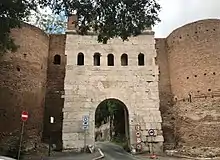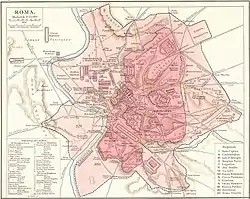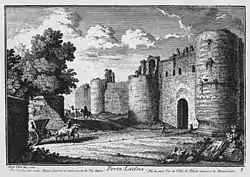Porta Latina
The Porta Latina (Latin - Latin Gate) is a single-arched gate in the Aurelian Walls of ancient Rome. It marked the Rome end of the Via Latina and gives its name to the church of San Giovanni a Porta Latina. Most of the present structure dates to Honorius, including the arch's voussoirs (though they are often wrongly attributed[1] to a 6th-century restoration by Belisarius, due to a cross and circle sculpted on the inner keystone, and the Chi Rho between Α and Ω sculpted on the outer keystone). The gate retained its name throughout the Middle Ages. Also nearby are the oratory of San Giovanni in Oleo[2][3] and the pagan Columbarium of Pomponius Hylas.
| Porta Latina | |
|---|---|
 | |
| Location | Regio XII Piscina Publica |
| Built in | 5th century A.D. |
| Built by/for | Honorius |
| Type of structure | City gate |
| Related | List of ancient monuments in Rome |
  Porta Latina | |

The gate's single arch is built of irregular blocks of travertine, with a row of five windows above on the outside, and a sixth in brick, at the south end, surmounted by stone battlements. The arch is flanked by two semi-circular towers of brick-faced concrete (almost entirely rebuilt, probably in the 6th century), which do not rise above the top of the central section. The north tower rests on masonry foundations that may have belonged to a tomb.
Notes
- As in Touring Club Italiano, Roma e dintorni (Milan 1965), p. 388.
- Giovanni Mario Crescimbeni (1716). L' Istoria della Chiesa di S. Giovanni avanti Porta Latina.
- Hendrik W. Dey (7 April 2011). The Aurelian Wall and the Refashioning of Imperial Rome, AD 271–855. Cambridge University Press. pp. 206–. ISBN 978-1-139-50038-8.
Sources
| Wikimedia Commons has media related to Porta Latina (Rome). |
This article contains text from Platner and Ashby's A Topographical Dictionary of Ancient Rome, a text now in the public domain.